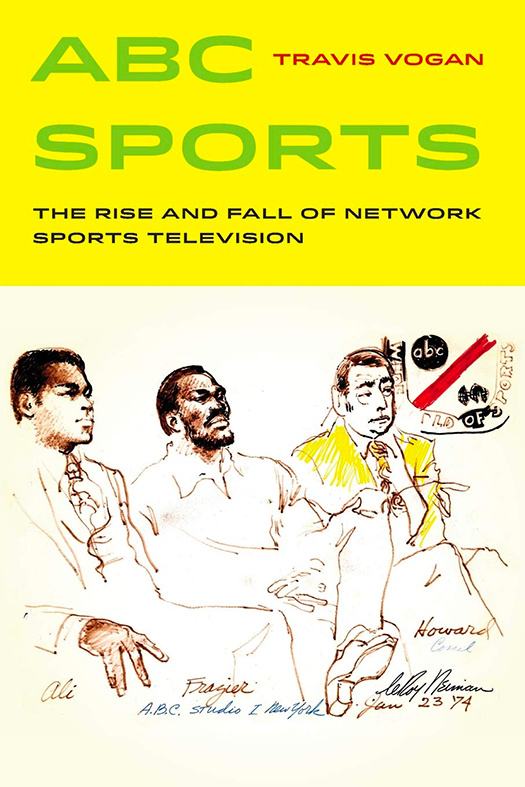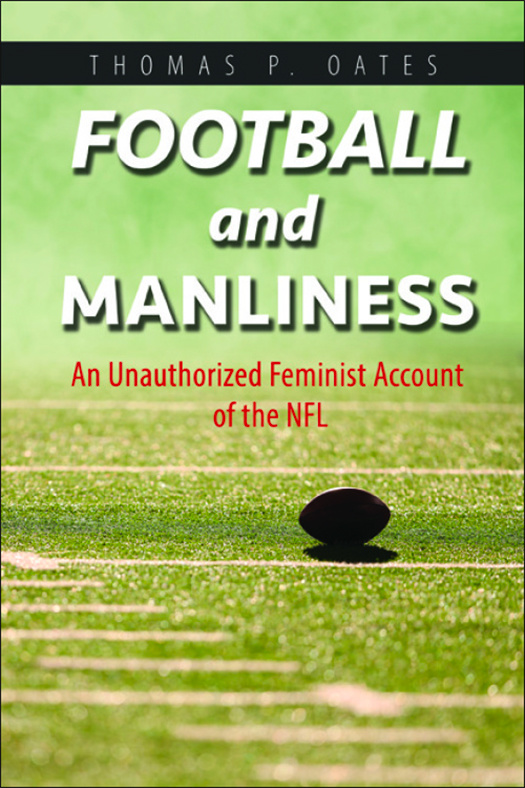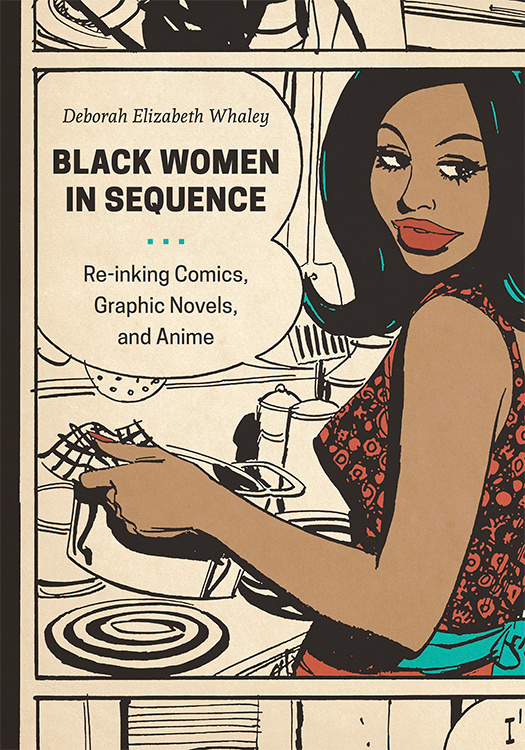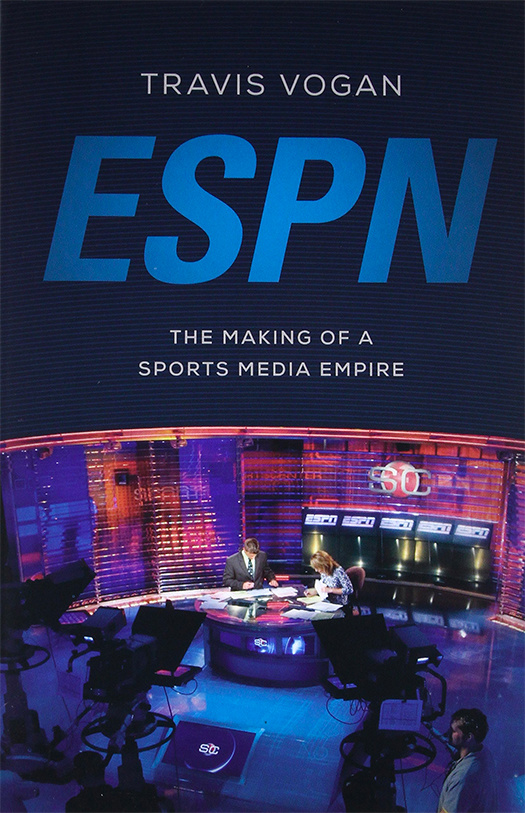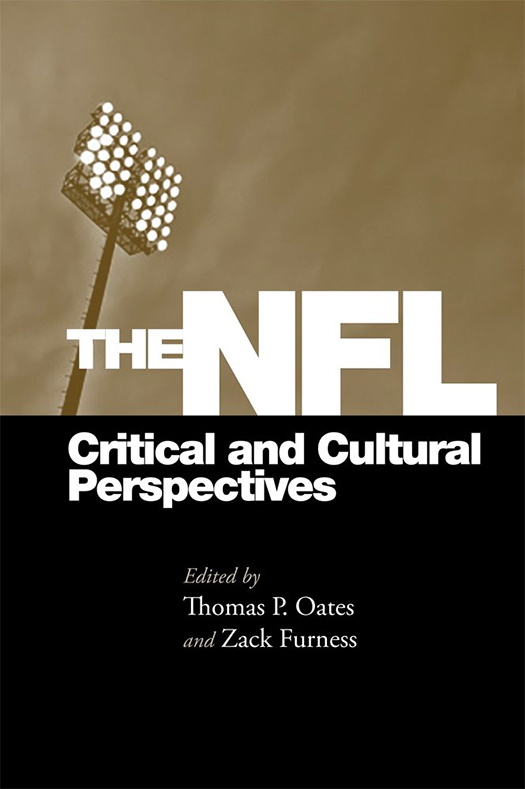Main navigation
Dive deeper into American Studies
Meat Packing America: How Migration, Work, and Faith Unite and Divide the Heartland
Meat Packing America: How Migration, Work, and Faith Unite and Divide the Heartland (2021)
Kristy Nabhan-Warren
ABC Sports: The Rise and Fall of Network Sports Television
ABC Sports: The Rise and Fall of Network Sports Television (2018)
Travis Vogan
ABC Sports shaped how the world consumes sport. The American Broadcasting Company's sports division is behind some of network television's most significant practices, celebrated personalities, and iconic moments. It created the weekend anthology Wide World of Sports, transformed professional football into a prime-time spectacle with Monday Night Football, fashioned the Olympics into a mega media event, and even revolutionized TV news. Travis Vogan's cultural and institutional history of ABC Sports examines the development of network sports television in the United States and the aesthetic, cultural, political, and industrial practices that mark it. ABC Sports traces the storied division from its beginnings through the internet age to reveal the changes it endured along with the new sports media environment it spawned.
The Latina/o Midwest Reader
The Latina/o Midwest Reader (2017)
Claire Fox (Co-editor with Omar Valerio-Jiménez and Santiago Vaquera-Vásquez)
Showing Off, Showing Up: Studies of Hype, Heightened Performance, and Cultural Power
Showing Off, Showing Up: Studies of Hype, Heightened Performance, and Cultural Power (2017)
Kim Marra
The interdisciplinary essays in Showing Off, Showing Up examine acts of showing, a particular species of performance that relies on competition and judgment, active spectatorship, embodied excess, and exposure of core values and hidden truths. Acts of showing highlight those dimensions of performance that can most manipulate spectators and consumers, often through over-the-top heightening and skewing of presentation. Many forms of showing and of heightened performance, however, operate more enigmatically and covertly while still profoundly affecting the social world, even if our reactions to them are initially flippant or unconcerned because “it’s just a show.” Examining a wide range of examples—from dog shows to competitive dancing to carnivals to striptease, the essays illuminate how such events variously foster competition, exaggerate a characteristic, and reveal hidden truths. There is as much to be learned about the power of showing through subtlety and underlying intentionality as through overt display. The book’s theoretical introduction and 12 essays by leading scholars reveal how diverse, particularly efficacious genres of showing are theoretically connected and why they merit more concerted attention, especially in the 21st century.
Football and Manliness: An Unauthorized Feminist Account of the NFL
Football and Manliness: An Unauthorized Feminist Account of the NFL (2017)
Thomas Oates
Women, African Americans, and gays have recently upended US culture with demands for inclusion and respect, while economic changes have transformed work and daily life for millions of Americans. The national obsession with the National Football League provides a window on this dynamic period of change, reshaping ideas about manliness to respond to new urgencies on and beyond the gridiron.
Thomas P. Oates uses feminist theory to break down the dynamic cultural politics shaping and shaped by today's NFL. As he shows, the league's wildly popular product provides an arena for media producers to work out and recalibrate the anxieties, contradictions, and challenges that characterize contemporary masculinity. Oates draws from a range of pop culture narratives to map the complex set of theories about gender and race and to reveal a league and fan base in flux. Though longing for a past dominated by white masculinity, the mediated NFL also subtly aligns with a new economic reality that demands it cope with the shifting relations of gender, race, sexuality, and class. Indeed, pro football crafts new meanings of each by its canny mobilization of historic ideological processes.
Black Women in Sequence: Re-inking Comics, Graphic Novels, and Anime
Black Women in Sequence: Re-inking Comics, Graphic Novels, and Anime (2015)
Deborah E. Whaley
Black Women in Sequence takes readers on a search for women of African descent in comics subculture. From the 1971 appearance of the Skywald Publications character "the Butterfly" - the first Black female superheroine in a comic book - to contemporary comic books, graphic novels, film, manga, and video gaming, a growing number of Black women are becoming producers, viewers, and subjects of sequential art.
As the first detailed investigation of Black women’s participation in comic art, Black Women in Sequence examines the representation, production, and transnational circulation of women of African descent in the sequential art world. In this groundbreaking study, which includes interviews with artists and writers, Deborah Whaley suggests that the treatment of the Black female subject in sequential art says much about the place of people of African descent in national ideology in the United States and abroad.
Playing to Win: Sports, Video Games, and the Culture of Play
Playing to Win: Sports, Video Games, and the Culture of Play (2015)
Thomas Oates
In this era of big media franchises, sports branding has crossed platforms, so that the sport, its television broadcast, and its replication in an electronic game are packaged and promoted as part of the same fan experience. Editors Robert Alan Brookey and Thomas P. Oates trace this development back to the unexpected success of Atari's Pong in the 1970s, which provoked a flood of sport simulation games that have had an impact on every sector of the electronic game market. From golf to football, basketball to step aerobics, electronic sports games are as familiar in the American household as the televised sporting events they simulate. This book explores the points of convergence at which gaming and sports culture merge.
ESPN: The Making of a Sports Media Empire
ESPN: The Making of a Sports Media Empire (2015)
Travis Vogan
Once a shoestring operation built on plywood sets and Australian rules football, ESPN has evolved into a media colossus. A genius for cross-promotion and its near-mystical rapport with its viewers empower the network to set agendas and create superstars, to curate sports history even as it mainstreams the latest cultural trends.
Travis Vogan teams archival research and interviews with an all-star cast to pen the definitive account of how ESPN turned X's and O's into billions of $$$. Vogan's institutional and cultural history focuses on the network since 1998, the year it launched a high-motor effort to craft its brand and grow audiences across media platforms. As he shows, innovative properties like SportsCentury, ESPN The Magazine, and 30 for 30 built the network's cultural caché. This credibility, in turn, propelled ESPN's transformation into an entity that lapped its run-of-the-mill competitors and helped fulfill its self-proclaimed status as the "Worldwide Leader in Sports."
The NFL: Critical and Cultural Perspectives
The NFL: Critical and Cultural Perspectives (2014)
Thomas Oates
The National Football League is one of the most significant cultural engines in contemporary American life. Yet despite intense and near ubiquitous media coverage, commentators rarely turn a critical lens on the league to ask what material and social forces have contributed to its success, and how the NFL has influenced public life in the United States.
The editors of and contributors to The NFL examine the league as a culturally, economically, and politically powerful presence in American life. The essays explore how the NFL is packaged for commercial consumption, the league's influence on American identity, and its relationship to state and cultural militarism.
The NFL is the first collection of critical essays to focus attention on the NFL as a cultural force. It boldly moves beyond popular celebrations of the sport and toward a fuller understanding of football's role in shaping contemporary sport, media, and everyday life.
The Worlds the Shawnees Made: Migration and Violence in Early America
The Worlds the Shawnees Made: Migration and Violence in Early America (2014)
Stephen Warren
In 1779, Shawnees from Chillicothe, a community in the Ohio country, told the British, "We have always been the frontier." Their statement challenges an oft-held belief that American Indians derive their unique identities from longstanding ties to native lands. By tracking Shawnee people and migrations from 1400 to 1754, Stephen Warren illustrates how Shawnees made a life for themselves at the crossroads of empires and competing tribes, embracing mobility and often moving willingly toward violent borderlands. By the middle of the eighteenth century, the Shawnees ranged over the eastern half of North America and used their knowledge to foster notions of pan-Indian identity that shaped relations between Native Americans and settlers in the revolutionary era and beyond.
Warren's deft analysis makes clear that Shawnees were not anomalous among Native peoples east of the Mississippi. Through migration, they and their neighbors adapted to disease, warfare, and dislocation by interacting with colonizers as slavers, mercenaries, guides, and traders. These adaptations enabled them to preserve their cultural identities and resist coalescence without forsaking their linguistic and religious traditions.
Keepers of the Flame: NFL Films, Pro Football, and the Rise of Sports Media in America
Keepers of the Flame: NFL Films, Pro Football, and the Rise of Sports Media in America (2014)
Travis Vogan
NFL Films changed the way Americans viewed professional football. In Keepers of the Flame: NFL Films and the Rise of Sports Media, Travis Vogan presents NFL Films' rise from a small independent production company to a marketing machine Sports Illustrated called "perhaps the most effective propaganda organ in the history of corporate America."
Drawing on research at the NFL Films Archive and the Pro Football Hall of Fame and interviews with media pioneer Steve Sabol and others, Vogan traces how NFL Films constructed a romanticized, remarkably visible mythology for the National Football League by packaging pro football as a heroic sequence of violent and beautiful gridiron battles. John Facenda's honeyed "Voice of God" baritone and Sam Spence's soaring scores merged with the epic poetry in Steve Sabol's scripts to create a hugely successful entertainment formula still used today.
Vogan also shows the company's relationship with and vast influence on our culture's representations of sport, the expansion of sports television beyond live game broadcasts, and the emergence of cable television and Internet sports media. His analysis presents sports media as an integral facet of American popular culture, and NFL Films as key to the transformation of pro football into the national obsession known as America's Game.
Old and New New Englanders: Immigration and Regional Identity in the Gilded Age
Old and New New Englanders: Immigration and Regional Identity in the Gilded Age (2014)
Bluford Adams
In Old and New New Englanders, Bluford Adams provides a reenvisioning of New England’s history and regional identity by exploring the ways the arrival of waves of immigrants from Europe and Canada transformed what it meant to be a New Englander during the Gilded Age. Adams’s intervention challenges a number of long-standing conceptions of New England, offering a detailed and complex portrayal of the relations between New England’s Yankees and immigrants that goes beyond nativism and assimilation. In focusing on immigration in this period, Adams provides a fresh view on New England’s regional identity, moving forward from Pilgrims, Puritans, and their descendants and emphasizing the role immigrants played in shaping the region’s various meanings. Furthermore, many researchers have overlooked the newcomers’ relationship to the regional identities they found here. Adams argues immigrants took their ties to New England seriously. Although they often disagreed about the nature of those ties, many immigrant leaders believed identification with New England would benefit their peoples in their struggles both in the United States and back in their ancestral lands.
Drawing on and contributing to work in immigration history, as well as American, gender, ethnic, and New England studies, this book is broadly concerned with the history of identity construction in the United States while its primary focus is the relationship between regional categories of identity and those based on race and ethnicity. With its interdisciplinary methodology, original research, and diverse chapter topics, the book targets both specialist and nonspecialist readers.
Making Art Panamerican: Cultural Policy and the Cold War
Making Art Panamerican: Cultural Policy and the Cold War (2013)
Claire Fox
Among the buildings on the National Mall in Washington, D.C., only the Pan American Union (PAU) houses an international organization. The first of many anticipated “peace palaces”constructed in the early twentieth century, the PAU began with a mission of cultural diplomacy, and after World War II its Visual Arts Section became a leader in the burgeoning hemispheric arts scene, proclaiming Latin America’s entrée into the international community as it forged connections between a growing base of middle-class art consumers on one hand and concepts of supranational citizenship and political and economic liberalism on the other.
Making Art Panamerican situates the ambitious visual arts programs of the PAU within the broader context of hemispheric cultural relations during the cold war. Focusing on the institutional interactions among aesthetic movements, cultural policy, and viewing publics, Claire F. Fox contends that in the postwar years, the PAU Visual Arts Section emerged as a major transfer point of hemispheric American modernist movements and played an important role in the consolidation of Latin American art as a continental object of study.
As it traces the careers of individual cultural policymakers and artists who intersected with the PAU in the two postwar decades—such as Concha Romero James, Charles Seeger, José Gómez Sicre, José Luis Cuevas, and Rafael Squirru—the book also charts the trajectories and displacements of sectors of the U.S. and Latin American intellectual left during a tumultuous interval that spans the Mexican Revolution, the Spanish Civil War, the New Deal, and the early cold war. Challenging the U.S. bias of conventional narratives about Panamericanism and the postwar shift in critical values from realism to abstraction, Making Art Panamerican illuminates the institutional dynamics that helped shape aesthetic movements in the critical decades following World War II.
The Cursillo Movement in America: Catholics, Protestants, and Fourth-Day Spirituality
The Cursillo Movement in America: Catholics, Protestants, and Fourth-Day Spirituality (2013)
Kristy Nabhan-Warren
Electric Dreamland: Amusement Parks, Movies, and American Modernity
Electric Dreamland: Amusement Parks, Movies, and American Modernity (2012)
Lauren Rabinovitz
Amusement parks were the playgrounds of the working class in the early twentieth century, combining numerous, mechanically-based spectacles into one unique, modern cultural phenomenon. Lauren Rabinovitz describes the urban modernity engendered by these parks and their media, encouraging ordinary individuals to sense, interpret, and embody a burgeoning national identity. As industrialization, urbanization, and immigration upended society, amusement parks tempered the shocks of racial, ethnic, and cultural conflict while shrinking the distinctions between gender and class. Following the rise of American parks from 1896 to 1918, Rabinovitz seizes on a simultaneous increase in cinema and spectacle audiences and connects both to the success of leisure activities in stabilizing society. Critics of the time often condemned parks and movies for inciting moral decline, yet in fact they fostered women's independence, racial uplift, and assimilation. The rhythmic, mechanical movements of spectacle also conditioned audiences to process multiple stimuli. Featuring illustrations from private collections and accounts from unaccessed archives, Electric Dreamland joins film and historical analyses in a rare portrait of mass entertainment and the modern eye.
Disciplining Women
Disciplining Women (2010)
Deborah Whaley
Disciplining Women focuses on the oldest Black Greek-letter sorority, Alpha Kappa Alpha (AKA), established in 1908. In this innovative interdisciplinary analysis of AKA, Deborah Elizabeth Whaley combines ethnographic fieldwork, archival research, oral history, and interpretive readings of popular culture and sorority rituals to examine the role of the Black sorority in women's everyday lives and more broadly within public life and politics.
Untimely Ruins: An Archaeology of American Urban Modernity, 1819-1919
Untimely Ruins: An Archaeology of American Urban Modernity, 1819-1919 (2009)
Nick Yablon
American ruins have become increasingly prominent, whether in discussions of “urban blight” and home foreclosures, in commemorations of 9/11, or in postapocalyptic movies. In this highly original book, Nick Yablon argues that the association between American cities and ruins dates back to a much earlier period in the nation’s history. Recovering numerous scenes of urban desolation—from failed banks, abandoned towns, and dilapidated tenements to the crumbling skyscrapers and bridges envisioned in science fiction and cartoons—Untimely Ruins challenges the myth that ruins were absent or insignificant objects in nineteenth-century America.
The first book to document an American cult of the ruin, Untimely Ruins traces its deviations as well as derivations from European conventions. Unlike classical and Gothic ruins, which decayed gracefully over centuries and inspired philosophical meditations about the fate of civilizations, America’s ruins were often “untimely,” appearing unpredictably and disappearing before they could accrue an aura of age. As modern ruins of steel and iron, they stimulated critical reflections about contemporary cities, and the unfamiliar kinds of experience they enabled. Unearthing evocative sources everywhere from the archives of amateur photographers to the contents of time-capsules, Untimely Ruins exposes crucial debates about the economic, technological, and cultural transformations known as urban modernity. The result is a fascinating cultural history that uncovers fresh perspectives on the American city.
Strange Duets: Impresarios and Actresses in the American Theatre, 1865-1914
Strange Duets: Impresarios and Actresses in the American Theatre, 1865-1914 (2006)
Kim Marra
Autocratic male impresarios increasingly dominated the American stage between 1865 and 1914. Many rose from poor immigrant roots and built their own careers by making huge stars out of “undiscovered,” Anglo-identified actresses. Reflecting the antics of self-made industrial empire-builders and independent, challenging New Women, these theatrical potentates and their protégées gained a level of wealth and celebrity comparable to that of Hollywood stars today. In her engaging and provocative Strange Duets, Kim Marra spotlights three passionate impresario-actress relationships of exceptional duration that encapsulated the social tensions of the day and strongly influenced the theatre of the twentieth century.
The Shawnees and Their Neighbors, 1795-1870
The Shawnees and Their Neighbors, 1795-1870 (2005)
Stephen Warren
Stephen Warren traces the transformation in Shawnee sociopolitical organization over seventy years as it changed from village-centric, multi-tribe kin groups to an institutionalized national government led by wealthy men with only marginal kin ties to the people they claimed to represent. The Shawnees and Their Neighbors, 1795-1870 lays bare the myths and histories produced by Shawnee interpreters and their vested interests in modernizing the tribes.
Until recently, historians have assumed that Central Algonquians derive from politically unified tribes, but by analyzing the crucial role that individuals, institutions, and policies played in shaping modern tribal governments, Warren reveals a messier, more complicated history of migration and conflict. Ultimately, Warren establishes that the form of the modern Shawnee "tribe" was coerced in accordance with the U.S. government's desire for an entity with whom to do business, rather than as a natural development of traditional Shawnee ways.
The Gay and Lesbian Theatrical Legacy: A Biographical Dictionary of Major Figures of the American Stage in the Pre-Stonewall Era
The Gay and Lesbian Theatrical Legacy: A Biographical Dictionary of Major Figures of the American Stage in the Pre-Stonewall Era (2005)
Kim Marra
The Gay and Lesbian Theatrical Legacy collects in a single volume biographies of more than one hundred notable figures whose careers flourished in the years before the 1969 Stonewall Riots marked the beginning of the gay and lesbian civil rights movement in the United States. The leading lights in American theater have included innumerable individuals whose sexualities have deviated from prevailing norms, but this history has until recently been largely unwritten and unknown. This book contributes significantly to the recovery of this history, fashioning a much fuller, more nuanced portrait of American theater as it evolved and shedding light on the influence that sexual desire may have had on professional choices, relationships, and artistic achievements.
The Gay and Lesbian Theatrical Legacy collects biographies and portraits of influential actors, playwrights, composers, directors, designers, dancers, producers, managers, critics, choreographers, and technicians who made their mark on the American theater. Its broad coverage provides an extended glimpse into lives and careers that intersected and into networks of affiliation that made theatrical history and, by extension, social and cultural history.
Memory Bytes: History, Technology, and Digital Culture
Memory Bytes: History, Technology, and Digital Culture (2004)
Lauren Rabinovitz
Digital culture is often characterized as radically breaking with past technologies, practices, and ideologies rather than as reflecting or incorporating them. Memory Bytes seeks to counter such ahistoricism, arguing for the need to understand digital culture—and its social, political, and ethical ramifications—in historical and philosophical context. Looking at a broad range of technologies, including photography, print and digital media, heat engines, stereographs, and medical imaging, the contributors present a number of different perspectives from which to reflect on the nature of media change. While foregrounding the challenges of drawing comparisons across varied media and eras, Memory Bytes explores how technologies have been integrated into society at different moments in time.
Staging Desire: Queer Readings of American Theater History
Staging Desire: Queer Readings of American Theater History (2002)
Kim Marra
Staging Desire gathers critical and biographical essays on notable stage personalities who made their mark before 1969, when the Stonewall riots accelerated the lesbian and gay rights movement in the United States. How they staged their unconventional sexualities greatly influenced the course of their personal and professional lives, and thus the course of American theater history. The book builds on an earlier collection—the well-received Passing Performances, which focused on actors, directors, producers, and agents—by examining playwrights, lyricists, critics, and designers. Shaping theatrical representations from offstage, these practitioners exploited the special opportunities theater offered as a complex and many-layered medium for expression of transgressive desire.
Essays cover the careers of major figures Clyde Fitch, Rachel Crothers, Mercedes de Acosta, Djuna Barnes, Cole Porter, Lorenz Hart, George Kelly, William Inge, James "Acorn" Oaks, Adam "Vagabond" Badeau, Eric Bentley, Loie Fuller, Robert Edmond Jones, and Jean Rosenthal. Grounded in research into the history of sexuality, the book engages central problems of terminology and evidence in analyzing sexual practices of the past and the modes of articulation of sexuality in theater, conditioned by American culture's peculiar anxieties about both.
More Than Mere Amusement: Working-Class Women's Leisure in England, 1750-1914
More Than Mere Amusement: Working-Class Women's Leisure in England, 1750-1914 (2001)
Catriona (Tina) Parratt
This groundbreaking study surveys how working-class women, restricted by gender, time, and financial means, as well as cultural and social tensions, managed to find spheres of leisure and recreation.
Reading Sport: Critical Essays on Power and Representation
Reading Sport: Critical Essays on Power and Representation (2000)
Susan Birrell
Reading Sport begins with an insightful introduction by the editors that provides theoretical frameworks and analytical tools for reading sport. The selections that follow critically examine how the complexities and intersections of power are reflected in particular high-profile incidents and celebrity athletes. Included are such figures as Dennis Rodman, Nolan Ryan, Michael Jordan, Nancy Lopez, O.J. Simpson, Renee Richards, Nancy Kerrigan, and Tonya Harding.
Taken together, the essays demonstrate that sports events and personalities exist within broader cultural, economic, historical, and political realms. The work makes a valuable and timely contribution to the emerging field of sport study and sets the stage for further discussions of power and representation.
The Fence and the River: Culture and Politics at the U.S. - Mexico Border
Television, History, and American Culture: Feminist Critical Essays
Television, History, and American Culture: Feminist Critical Essays (1999)
Lauren Rabinovitz
In less than a century, the flickering blue-gray light of the television screen has become a cultural icon. What do the images transmitted by that screen tell us about power, authority, gender stereotypes, and ideology in the United States? Television, History, and American Culture addresses this question by illuminating how television both reflects and influences American culture and identity.
The essays collected here focus on women in front of, behind, and on the TV screen, as producers, viewers, and characters. Using feminist and historical criticism, the contributors investigate how television has shaped our understanding of gender, power, race, ethnicity, and sexuality from the 1950s to the present. The topics range from the role that women broadcasters played in radio and early television to the attempts of Desilu Productions to present acceptable images of Hispanic identity, from the impact of TV talk shows on public discourse and the politics of offering viewers positive images of fat women to the negotiation of civil rights, feminism, and abortion rights on news programs and shows such as I Spy and Peyton Place. Innovative and accessible, this book will appeal to those interested in women’s studies, American studies, and popular culture and the critical study of television.
Passing Performances: Queer Readings of Leading Players in American Theater History
Passing Performances: Queer Readings of Leading Players in American Theater History (1998)
Kim Marra
Passing Performances gathers a range of critical and biographical essays on notable personalities whose major contributions to the stage occurred before 1969, the year of the Stonewall riots that kicked off the gay rights movement in the United States. How these theater practitioners variously "passed"—i.e., managed unconventional sexual inclinations both on- and offstage—significantly determined the course of their personal and professional lives and thus the course of U.S. theater history.
The actors, directors, producers, and agents examined here include Edwin Forrest, Charlotte Cushman, and Adah Isaacs Menken, whose personal lives and careers traded on the same-sex erotics of "true love" in the antebellum period; Elisabeth Marbury, Elsie de Wolfe, Elsie Janis, Nance O'Neil, and Alla Nazimova, whose intimate female liaisons were variously interpreted around the turn of the century; the "lavender marriages" of Alfred Lunt to Lynne Fontanne and Guthrie McClintic to Katharine Cornell; the lesbian collaborations of Margaret Webster and Cheryl Crawford; the comic antics of Monty Woolley, which negotiated codified constructions of homosexual perversion in the post-Freudian interwar years; and the on- and offstage performances of Mary Martin and Joe Cino, which resisted the paranoid enforcements of heterosexual normality in the McCarthy era. Central to these investigations are the complex connections of performances of sexuality and gender and their different implications for men and women practitioners working under pervasive sexism and homophobia.
The volume also includes striking archival photographs of the performers and their performances, and an index to facilitate the cross-referencing of subjects' intersecting careers. Passing Performances will engage both general and academic readers interested in theater, gay and lesbian history, American studies, and biography.
For the Love of Pleasure: Women, Movies, and Culture in Turn-of-the-Century Chicago
For the Love of Pleasure: Women, Movies, and Culture in Turn-of-the-Century Chicago (1998)
Lauren Rabinovitz
The period from the 1880s until the 1920s saw the making of a consumer society, the inception of the technological, economic, and social landscape in which we currently live. Cinema played a key role in the changing urban landscape. For working-class women, it became a refuge from the factory. For middle-class women, it presented a new language of sexual danger and pleasure. Women found greater freedom in big cities, entering the workforce in record numbers and moving about unchaperoned in public spaces. Turn-of-the-century Chicago surpassed even New York as a proving ground for pleasure and education, attracting women workers at three times the national rate. Using Chicago as a model, Lauren Rabinovitz analyzes the rich interplay among demographic, visual, historical, and theoretical materials of the period. She skillfully links cinema theory and women's studies for a fuller understanding of cultural history. She also demonstrates how cinema dramatically affected social conventions, ultimately shaping modern codes of masculinity and feminity.
Women, Sport and Culture
Women, Sport and Culture (1994)
Susan Birrell
Seeing Through the Media: The Persian Gulf War
Seeing Through the Media: The Persian Gulf War (1994)
Lauren Rabinovitz
Points of Resistance: Women, Power & Politics in the New York Avant-garde Cinema, 1943-71
Points of Resistance: Women, Power & Politics in the New York Avant-garde Cinema, 1943-71 (1991; 2nd Edition - 2003)
Lauren Rabinovitz
In detailing the relationship of three women filmmakers’ lives and films to the changing institutions of the post-World War II era, Lauren Rabinovitz has created the first feminist social history of the North American avant-garde cinema.
At a time when there were few women directors in commercial films, the postwar avant-garde movement offered an opportunity. Rabinovitz argues that avant-garde cinema, open to women because of its marginal status in the art world, included women as filmmakers, organizers, and critics.
Focusing on Maya Deren, Shirley Clarke, and Joyce Wieland, Rabinovitz illustrates how women used bold physical images to enhance their work and how each provided entrée to her subversive art while remaining culturally acceptable. She combines archival materials with her own interviews to show how the women’s labor and films, even their identities as women filmmakers, were produced, disseminated, and understood. With a new preface and an updated bibliography, Points of Resistance simultaneously demonstrates the avant-garde’s importance as an organizational network for women filmmakers and the processes by which women remained marginal figures within that network.
